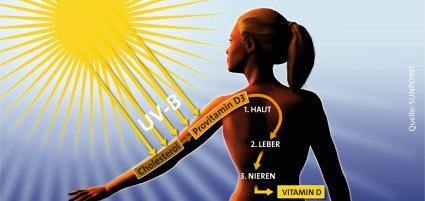Questions and Answers | Tanning
We bring light into the darkness on the topic of tanning: How much sun do you need? How does the skin tan and what about the sun hormone vitamin D? And what about….? You will find answers in this section!
DOES THE BODY NEED UV LIGHT?
- “Light is life”. This famous saying has a lot of scientific background.
- Without light, we could not exist in the long run and would get many physical or mental infirmities and diseases.
- Our body demands UV light. Therefore you can see people walking out the door and enjoying the sun at the first ray of sunshine.
- Many biopositive effects are produced by UV light, which is vital to us.
- Examples include vitamin D formation, sun protection through tanning, circulatory stabilization, stimulation of the immune system, increase in performance, treatment of skin diseases, alleviation of depression.
WHAT DOES SUNLIGHT CONSIST OF?
- Infrared radiation that the body transforms into heat
- Visible light
- UV radiation (long-wave UVA and short-wave UVB)
- In different compositions, depending on latitude and year/time
WHAT IS ARTIFICIAL UV RADIATION?
- Scientifically, UV radiation is called “electromagnetic radiation”.
- Physically, there is only one form of electromagnetic radiation. The natural one.
- Therefore, there is no artificial electromagnetic radiation.
- Of course, you can artificially generate this radiation, but then the product is a natural one.
- UV light consists of UVA (wavelength range 320nm-400nm), UVB (280-320nm) and UVC (200-280nm)
- Sunlight and sunbeds provide only UVA and UVB radiation.
WHAT EFFECT DOES UV LIGHT HAVE?
- UVA:
- Sun tan (darkening of the pigments)
- Sunscreen and UV dosage through tanned skin
- Skin aging at high dosage
- phototherapeutic effects (e.g. relief or cure skin diseases)
- UVB:
- Formation of new pigments
- Formation of provitamin D3
- Sunburn at high dosage
- Formation of light callosity
- Strengthening the cardiovascular system
- Therapy of skin diseases
- UVC:
- Not included in our atmosphere and not in the solarium
- Very high energy and dangerous radiation
- For example used for disinfection and sterilisation
WHAT IS THE SIGNIFICANCE OF VITAMIN D3?
- The VD3 is needed for muscle building and bone formation. It contributes to the functioning of the cardiovascular system, is necessary for the lung to oxygenate, in cell division and plays a crucial role in our immune system.
- The so-called sun hormone VD3 is produced as provitamin via the tanning in the skin and then converted into the VD3 in the liver and the kidney:

- Even short and regular tanning times can bring the VD3 level up to the required level.
And the beauty is: in contrast to a supply of vitamin tablets, the natural production cannot be overdosed.
HOW OFTEN IS A TANNING SESSION RECOMMENDED TO MAINTAIN THE TAN?
- This is highly dependent on the skin type and the intensity of the radiation.
- On average, a 10-minute tanning session is sufficient 2-3 times per week.
CAN CONTACT LENSES BE WORN WHILE TANNING?
- Generally this is not recommended.
- Due to the high heat output of the sun and solarium, the film of water under the contact lenses can dry out and thus cause discomfort.
WHY DO SOME DERMATOLOGISTS ADVISE AGAINST TANNING?
- There are obviously two groups of dermatologists here.
- Some advise against, while others successfully treat skin diseases with UV light.
Since the body can only work with UV light, the negative attitude is incomprehensible and unnatural.
CAN ACNE BE TREATED WITH TANNING?
- Many skin diseases are treated by dermatologists using UV light.
- This is understandable, since the skin regenerates faster with tanning and thus can replace the irritated or disordered skin.
- So tanning can also help with acne. However, this must be judged by a doctor.
CAN SKIN DISEASES BE TREATED BY TANNING?
- Dermatologists often treat skin diseases with special UV radiation devices.
- In this case, tanning in the sun, or on a sunbed can have a therapeutic effect.
- But there are also diseases with which UV radiation can be harmful.
- An indication must always be given by a doctor.
CAN TANNING HELP WITH SEASONALLY DEPENDENT DEPRESSION?
- In general, tanning in the solarium is very helpful against SAD.
- Bright light is not only perceived through the eyes, but in particular by receptors in the forehead.
- This suppresses the hormone melatonin and makes people more euphoric and happy.
- Whether or not and to what extent further measures are required must always be decided by a doctor.
DOES TANNING ENHANCE SKIN WRINKLES?
- UV radiation not only regenerates cells, it also destroys the substructure of the skin at high doses, i.e. elastin and collagen fibers.
- As a result, the skin is no longer supported and “breaks in”. Wrinkles arise.
- This can be counteracted by the application of special lamps with red light in special solariums.
CAN YOU GO TANNING WHILE YOU ARE PREGNANT?
- The UV light is certainly not harmful in pregnancies.
- However, the heat radiation may be uncomfortable during pregnancy.
- Also, the high heat development can harm the unborn life.
- Please ask your doctor about this.
CAN THE PRESERVATION OF THE TAN BE SUPPORTED?
- Yes, if you care for a well-hydrated skin.
- This can be achieved by skin care products and by drinking enough water.
- Distance is to be taken from double tanning in the solarium and in the sun.
WHEN SHOULD ONE NOT TAN?
- As soon as the doctor discourages you.
- If you are skin type 1.
- If you are taking photosensitizing medications (such as antibiotics).
- If you have unexplained skin diseases.
WHY IS EYE PROTECTION NECESSARY WHEN TANNING?
- UV light can cloud the lenses and damage the retina.
- The eyelids cannot stop all radiation when being closed.
- Frequent eye irradiation can cause irreparable damage.
IS TAKING A SHOWER ADVISABLE BEFORE OR AFTER SUNBATHING?
- Whether you want to take a shower before or after a tanning session depends on your personal well-being and your hygiene.
- It has no influence at all on the tanning effect.
- Cosmetics and body lotion can easily be removed by showering.
- Many like to remove the so-called tanning smell by a shower after the tanning session.
- The skin layers in which the tanning happens are not affected by a shower, as the tanning is not a color application on the skin, but happens within the skin layers.
HOW DOES THE SKIN TAN?
- UV radiation stimulates the production of pigment (melanin) in the cells of the epidermis. These are small, pink platelets in the skin.
- During the next tanning session the pigment is then darkened.
- The level of the skin tan regulates how much UV is filtered and how much is transmitted. This is how the body protects itself from overdosing and at the same time ensures better UV absorption through the skin during the winter months.

